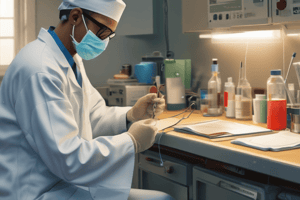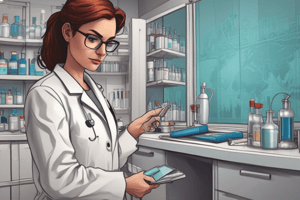Podcast
Questions and Answers
Class C fires are:
Class C fires are:
- Chemical fires
- Electrical fires (correct)
- Paper fires
- Wood fires
Which of the following is needed for cleanup of a chemical spill?
Which of the following is needed for cleanup of a chemical spill?
- Rubber gloves (correct)
- NIOSH TB respirator
- Nonlatex gloves
- Chlorhexidine
CPR stands for:
CPR stands for:
- Cardiopulmonary rescue
- Cardiopulmonary return
- Cardiopulmonary resuscitation (correct)
- Cardiopulmonary recovery
If a health care provider hears a fire alarm while collecting blood, they should not:
If a health care provider hears a fire alarm while collecting blood, they should not:
If a health care provider has a chemical spilled on them, they should immediately:
If a health care provider has a chemical spilled on them, they should immediately:
The first step in controlling severe bleeding is to:
The first step in controlling severe bleeding is to:
In the hazardous labeling system developed by the NFPA, the blue quadrant indicates a:
In the hazardous labeling system developed by the NFPA, the blue quadrant indicates a:
SDSs are required by the:
SDSs are required by the:
The health care provider is most likely to encounter which hazard in the nuclear medicine department?
The health care provider is most likely to encounter which hazard in the nuclear medicine department?
If a health care provider is in an area where a fire starts, they should first:
If a health care provider is in an area where a fire starts, they should first:
Which of the following should not be done for a shock victim who seems not fully conscious?
Which of the following should not be done for a shock victim who seems not fully conscious?
Which organization developed a labeling system for hazardous chemicals frequently used in health care facilities?
Which organization developed a labeling system for hazardous chemicals frequently used in health care facilities?
Chemicals defined as 'explosive flammables' must be stored:
Chemicals defined as 'explosive flammables' must be stored:
What are the major principles of self-protection from radiation exposure?
What are the major principles of self-protection from radiation exposure?
A dosimeter badge is required in health care facilities for:
A dosimeter badge is required in health care facilities for:
The HazCom standard requires chemical manufacturers to supply:
The HazCom standard requires chemical manufacturers to supply:
High exposures of radioactivity have been shown to lead to:
High exposures of radioactivity have been shown to lead to:
The abbreviation RACE is used in:
The abbreviation RACE is used in:
According to the hazard labeling system developed by NFPA, the yellow quadrant indicates a(n):
According to the hazard labeling system developed by NFPA, the yellow quadrant indicates a(n):
MSDS stands for:
MSDS stands for:
If a phlebotomist is collecting blood specimens from a patient in the nuclear medicine department, he or she needs to be:
If a phlebotomist is collecting blood specimens from a patient in the nuclear medicine department, he or she needs to be:
If a phlebotomist is exposed accidentally to a chemical spill on the floor, he or she should quickly go to which department for a chemical spill cleanup kit?
If a phlebotomist is exposed accidentally to a chemical spill on the floor, he or she should quickly go to which department for a chemical spill cleanup kit?
If an electrical accident occurs involving electrical shock to an employee or a patient, the health care provider should first:
If an electrical accident occurs involving electrical shock to an employee or a patient, the health care provider should first:
If a fire extinguisher has to be used in a health care environment, the first step to perform is:
If a fire extinguisher has to be used in a health care environment, the first step to perform is:
The first step in giving mouth-to-mouth resuscitation is to:
The first step in giving mouth-to-mouth resuscitation is to:
The dosimeter is a frequently used instrument for blood specimen preparation and testing.
The dosimeter is a frequently used instrument for blood specimen preparation and testing.
A carbon dioxide extinguisher can be used for Class B fires.
A carbon dioxide extinguisher can be used for Class B fires.
The GHS requires the use of HazCom's MSDSs.
The GHS requires the use of HazCom's MSDSs.
Some tourniquets contain latex.
Some tourniquets contain latex.
Severe bleeding from an open wound can be controlled by applying pressure directly below the wound.
Severe bleeding from an open wound can be controlled by applying pressure directly below the wound.
In case of a chemical spill in the eye, the victim should rinse their eyes with water for a minimum of 15 minutes.
In case of a chemical spill in the eye, the victim should rinse their eyes with water for a minimum of 15 minutes.
All disposable gloves are latex-free.
All disposable gloves are latex-free.
To save time, contact lenses should remain in the eyes prior to rinsing the eyes with water after a chemical spill.
To save time, contact lenses should remain in the eyes prior to rinsing the eyes with water after a chemical spill.
NFPA stands for National Fire Protection Association.
NFPA stands for National Fire Protection Association.
Class A fires require an ABC extinguisher.
Class A fires require an ABC extinguisher.
Flashcards are hidden until you start studying
Study Notes
Fire Safety and Hazards
- Class C fires are primarily electrical fires.
- Blue quadrant in the NFPA labeling system indicates a health hazard; yellow indicates instability.
- RACE is an acronym used during fire emergencies: Rescue, Alert, Contain, Extinguish.
- First use a fire alarm lever in case of fire before taking any other action.
Chemical Safety
- Rubber gloves are essential for the cleanup of chemical spills.
- The Global Harmonization System mandates Safety Data Sheets (SDSs).
- SDSs must be provided by chemical manufacturers under the Hazard Communication Standard.
- In a chemical spill, rinse exposed skin with water immediately; do not rub the area.
- For hazardous chemicals, specifically "explosive flammables," storage requires explosion-proof cabinets.
CPR and First Aid
- CPR stands for cardiopulmonary resuscitation; it's a lifesaving technique.
- The first step to control severe bleeding involves applying pressure directly to the wound.
- In case of shock, it is important to keep the airway open, but avoid giving fluids.
- For mouth-to-mouth resuscitation, first check if the victim is conscious by gently tapping and speaking loudly.
Radiation Safety
- A dosimeter badge is crucial in nuclear medicine to monitor radiation exposure.
- Major principles for self-protection from radiation include time, distance, and shielding.
- High exposure to radioactivity can lead to health issues such as leukemia.
Electrical Safety
- Shut off electrical power first in case of an electrical accident.
- If electrical shock occurs, prioritize safety before administering CPR.
Miscellaneous Safety Points
- Some tourniquets may contain latex material.
- Not all disposable gloves are latex-free; confirm the type before use.
- Contact lenses should be removed prior to eye rinsing in case of a chemical spill.
- Severe bleeding should be controlled by applying pressure directly above the wound, not below.
General Knowledge
- NFPA stands for National Fire Protection Association.
- Class A fires (wood, paper) typically require ABC extinguishers; Class B fires (flammables) can be put out using carbon dioxide extinguishers.
- The dosimeter is not used for blood specimen preparation or testing; it is a tool for radiation safety monitoring.
Studying That Suits You
Use AI to generate personalized quizzes and flashcards to suit your learning preferences.




